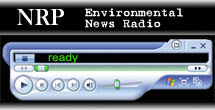In the United States, HIV/AIDS is no longer just a disease affecting white, gay men. The percentage of cases of women living with HIV has tripled in the past 20 years, and women of color are most affected. Yet outdated perceptions about the epidemic drive government prevention work, from the way data is collected to who gets tested.

On this edition, those on the frontlines of the grassroots HIV/AIDS movement bring the discussion about HIV risk up to date. They say generating more relevant prevention models is literally a matter of life and death, especially for women of color.
Greener Magazine
 Featuring::
Featuring::Silvia Martei, HIV positive woman in Oakland, CA; Naina Khanna, W.O.R.L.D. community outreach coordinator; Silvia Lopez, Co-Founder of the Women Rising Project; Waheedah Shabazz-El, ACT-UP Philadelphia member, Community HIV/AIDS Mobilization Project and Philadelphia FIGHT community organizer/trainer; Kenyon Farrow, Prevention Justice Mobilization Communications coordinator and Queers for Economic Justice board member; Ginger Virago, harm reduction specialist and Saint James Infirmary board member and case worker at “Positive She,” a University of San Francisco program for HIV-positive women; Esther Lucero, San Francisco Native American AIDS Project HIV case manager; L. Nyrobi N. Moss, Sister Love sexual health educator; Dazon Dixon Diallo, Sister Love intervention specialist founder/chief executive officer; Lisa Diane White, Sister Love program manager.
Senior Producer/Host: Tena Rubio
Managing Show Producer: Pauline Bartolone
Associate Producer: Puck Lo
Contributing Producer: Noah Chandler
Interns: Samson Reiny, Joaquin Palomino and Elena Botkin-Levy
Bonus Audio::At an October 22nd, 2007 Washington, DC press briefing called "Women and AIDS: Federal HIV-reporting policy and its impact on women," HIV organizations spoke to the need to make changes in the Centers for Disease Control's HIV surveillance system:
Colin Flynn, Chief of Surveillance and Epidemiology at the Maryland Dept. of Health and Hygiene's AIDS administration, presented the Council of State and Territorial Epidemiologists HIV surveillance position paper.
Carrie Broadus, Executive Director of the Women Alive Coalition, presented the National Women and AIDS Collective (NWAC) position paper.
Emerging radio producers Renita Pitts and Shanina Shumate created this 10-minute web segment:
Fighting AIDS in Oakland, a report on AIDS and African-American women featuring the voices of U.S. Congresswoman Barbara Lee, Dr. Robert Scott, Anita Schools of Women Overcoming Life Threatening Diseases (WORLD), Bishop Dr. Yvette Flounder, and Sheryl Lee Ralph.
For more information::
Sister Love
PO Box 10558
3709 Bakers Ferry Road, SW
Atlanta, GA 30331
404-505-7777; 866-750-7733
info@sisterlove.orgwww.sisterlove.orgAIDS Coalition to Unleash Power
PO Box 22439
Philadelphia, PA 19110
215-386-1981
actupp@critpath.orgwww.critpath.org/actup/W.O.R.L.D.
414 13th Street, 2nd Floor
Oakland, CA 94612
510-986-0340 x306
www.womenhiv.orgCommunity HIV/AIDS Mobilization Project
32 Broadway, Suite 1801
New York, NY 10004
212-937-7955
champ@champnetwork.orgwww.champnetwork.orgPrevention Justice Mobilization
www.preventionjustice.orgSt. James Infirmary
1372 Mission Street
San Francisco, CA 94103
415-554-8494
www.stjamesinfirmary.orgNative American AIDS Project
1540 Market Street, Suite 130
San Francisco, CA 94102
415-431-6227
www.naap-ca.orgTruth AIDS
PO Box 147
New York, NY 10035
646-707-0485
www.truthaids.orgCenters for Disease Control and Prevention
1600 Clifton Road
Atlanta, GA 30333
404-639-3534
800-311-3435
www.cdc.govNational Association of People with AIDS
8401 Colesville Road, Suite 750
Silver Spring, MD 20910
240-247-0880
www.napwa.orgPhiladelphia FIGHT
1233 Locust Street
Philadelphia, PA 19107
215-985-4448
www.fight.orgQueers for Economic Justice
16 West 32nd Street, #10H
New York, NY 10001
212-564-3608
http://qej.tripod.com/qej2/index.htmlAdditional information::Black Coalition on AIDS
2800 Third Street
San Francisco, CA 94107
415-615-9945
bcoa@bcoa.orgwww.bcoa.orgThe Philadelphia AIDS Consortium
112 North Broad Street, 9th Floor
Philadelphia, PA 19102
215-988-9970
comments@tpaconline.orgwww.tpaconline.orgPrevention Point Philadelphia
Trans Health Information Project (TIP)
166 Lehigh Avenue
Philadelphia, PA 19133
www.preventionpointphilly.org/services/services-trans.htmlAID Atlanta
1605 Peachtree Street NE
Atlanta, GA 30309
404-870-7700
www.aidatlanta.orgHarm Reduction Coalition
1440 Broadway, Suite 510
Oakland, CA 94612
510-444-6969
www.harmreduction.orgNew York State Black Gay Network
103 East 125th Street, Suite 7E
New York, NY 10035
212-828-9393
HIV/AIDS Amongst Women
www.cdc.gov/hiv/topics/women/resources/factsheets/women.htmMs. Foundation
The National Women and AIDS Collective
http://ms.foundation.org/wmspage.cfm?parm1=421http://ms.foundation.org/user-assets/PDF/Program/NWACpolicypaperFINAL81505.pdfFor a free video contact::HIV Positive Voices
www.hivpositivevoices.orgMusic::De La Soul - "Hey Love Love"
Ghetto Muffin - "Tsanana"
Unknown Artist - "Balm in Gilead"
Labels: Health
 I have one son and live with my family in Multan, a medium-sized city in Pakistan. My son is too young to attend school. My husband operates a fruit business that he would like to expand. He is requesting a loan of $250 for this purpose. He intends to buy seasonal fruits in bulk with your loan. We hope we will able to give our child a sound economic future.
I have one son and live with my family in Multan, a medium-sized city in Pakistan. My son is too young to attend school. My husband operates a fruit business that he would like to expand. He is requesting a loan of $250 for this purpose. He intends to buy seasonal fruits in bulk with your loan. We hope we will able to give our child a sound economic future. I have one son and live with my family in Multan, a medium-sized city in Pakistan. My son is too young to attend school. My husband operates a fruit business that he would like to expand. He is requesting a loan of $250 for this purpose. He intends to buy seasonal fruits in bulk with your loan. We hope we will able to give our child a sound economic future.
I have one son and live with my family in Multan, a medium-sized city in Pakistan. My son is too young to attend school. My husband operates a fruit business that he would like to expand. He is requesting a loan of $250 for this purpose. He intends to buy seasonal fruits in bulk with your loan. We hope we will able to give our child a sound economic future.














